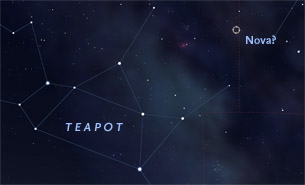A nova, discovered before dawn on April 21st, has flared to 9th magnitude along the border of Sagittarius and Ophiuchus.

An April 22nd image of a flaring 9th-magnitude star in Sagittarius, compared with a 1996 image of the same area taken during the Palomar Observatory Sky Survey.
E. Guido, N. Howes, & G. Sostero
Word has spread worldwide among dedicated skywatchers that there's a possible 9th-magnitude nova in Sagittarius near the Ophiuchus border. Its coordinates (17h 45m 28s, declination –23° 5′ 23″) place it 4° west of the Trifid Nebula (Messier 20).
Announced yesterday by the IAU's Central Bureau for Astronomical Telegrams, the "new star" was initially designated PNV J17452791-2305213 but now answers to Nova Sagittarii 2012. It was first spotted at magnitude 9.6 by Stanislav Korotkiy (Ka-Dar Observatory, Barybino, Russia) and Kirill Sokolovsky (Astro Space Center, Moscow State University) on a trio of images they'd taken with a 135-mm telephoto lens and ST-8300M digital camera. They've posted their discovery images here.

This finder chart shows the erupting star's location near the border of Sagittarius and Ophiuchus. Click on the image for a larger view, or use this AAVSO finder chart.
Source: Stellarium
A prediscovery image from Xingming Observatory in China shows that the star was magnitude 10.2 just four hours earlier, though Korotkiy and Sokolovskiy report nothing at that location brighter than 14th magnitude in images taken three days earlier. Follow-up observations taken this morning by Italian observers Ernesto Guido, Nick Howes, and Giovanni Sostero using a remotely controlled telescope in Mayhill, New Mexico, show the star had brightened slightly to magnitude 9.1.
The Italians also note on their Remanzacco Observatory website that a 16th-magnitude star is cataloged within a fraction of an arcsecond of the outburst's position.
A 25-minute observation late on April 21st by NASA's Swift spacecraft did not detect any X-rays, common in nova eruptions. This suggests to observers that "the observable part of the nova shell is expanding rather uniformly with no shocks strong enough to produce bright X-ray emission."
 8
8









Comments
lou
April 22, 2012 at 10:31 pm
WOW !!!!
You must be logged in to post a comment.
Anthony Barreiro
April 23, 2012 at 12:20 pm
This is interesting news. I wish I'd read about this yesterday morning when the sky was clear! I tried looking up the star in the USNO database, but I wasn't able to find any information. How far away is this possible supernova? Thanks.
You must be logged in to post a comment.
Mike Thibodeau
April 23, 2012 at 10:32 pm
How easy would I be able to find it, I live in western Canada.
Mike ([email protected])
You must be logged in to post a comment.
Paul Vondra
April 23, 2012 at 10:48 pm
Nova nomenclature has gotten out-of-control ridiculous. I remember seeing Nova Cygni 1992. Now THAT was a nova. Then in the late '90s we had Nova V something-or-other Aquilae. Now it's Nova PNV J17452791-2305213?? That looks more like my cable TV account number! Surely we can do better!
You must be logged in to post a comment.
Buddy Barbee
April 24, 2012 at 2:23 pm
I am not real sure what the letters PNV J stand for but this is a provisional designation for the super nova. The numbers though are the Right Assension (17h45m27.91s) and Declination (-23d05m21.3s) for the Nova. Later, if this is truly a Nova, a number will be asigned by the IAU for the Nova that will be composed of the year and a two or three letter sufix. Hope this helps a little.
You must be logged in to post a comment.
Caleb Vorwaller
April 27, 2012 at 1:46 pm
This is awesome. I'm going to look for it in the morning. The link to the AAVSO chart is not working. It says "Requested Page Not Found."
You must be logged in to post a comment.
Paul Martinez
April 28, 2012 at 8:54 pm
Looked yesterday, found nothing that bright, object in location at +12.2.
You must be logged in to post a comment.
Alex Kostin
April 30, 2012 at 9:41 pm
I took this photo last night using iTelescope T4. It's about +12
http://tiny.cc/ap1ldw
You must be logged in to post a comment.
You must be logged in to post a comment.